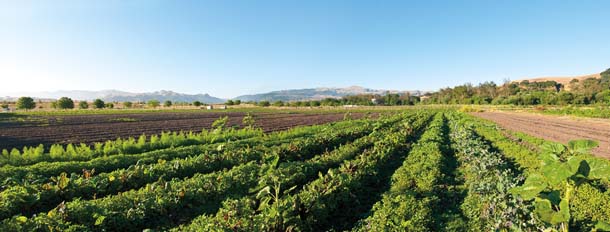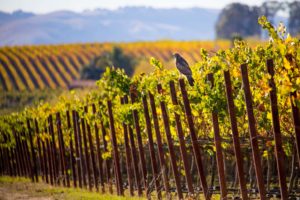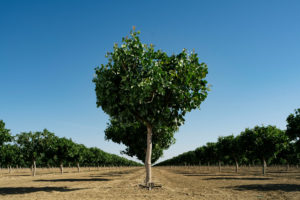On a typical early summer day at the Sunol Water Temple AgPark, Fred Hempel is multitasking. After advising two of his workers who are having trouble filling a restaurant order for edible radish pods, the wiry farmer fields phone calls as he walks between hunched rows of tomato plants, inspecting his most prized crop.
“Even with the cool weather the last couple of days these things are growing like crazy,” he says. “We really need to get them trellised up. Is that a ripening tomato over there? That’s amazing!”
He pulls out a pocketknife and the tomato–a muddy greenish-red–is sliced, tasted, and dismissed as too watery. To an untrained palate, the barely ripe fruit is better than any at the grocery store. But Hempel is a biotech research scientist turned tomato breeder turned farmer, and his preferences are exacting. He says they need to be.
“The tomatoes make the most money by far,” he says. “The first thing we think about every day is, ‘how are the tomatoes doing.'”
Yet diversity and creativity are essential to survival and success as a small commercial organic farmer, Hempel adds. In addition to the heirloom tomatoes, his 10-acre farm at the AgPark east of Fremont also grows unusual varieties of squash, peppers, exotic herbs, and edible flowers.
“We do a lot of testing of crops from other places,” he says, explaining that finding seeds that thrive in this particular place can be a time-consuming process. But the effort has been worth it, letting him build up a business working with high-end wholesalers, plus direct relationships with Bay Area restaurants that ask him to grow varieties they can’t get anywhere else. “The chef at Oliveto was in Italy a few months ago, and he brought back some stuff for us to grow,” Hempel says, pointing out some red-stalked corn seedlings in his greenhouse as an example.
Diversity and creativity are likewise hallmarks of the 18-acre AgPark in general. Though it looks like any other small farm–a patchwork of neatly tilled rows ribboned with dirt roads–this is in fact an innovative collaboration between a public agency, a nonprofit organization, and private businesses. Hempel’s Baia Nicchia is the largest of the four farms on the property. Others include Terra Bella, which grows produce for its community-supported agriculture business; Iu-Mien Village Farms, a collective of Laotian immigrants whose organic strawberries are sold at places like Monterey Market in Berkeley; and Fico, a small heirloom fig enterprise.
The AgPark is the brainchild of the nonprofit organization SAGE, or Sustainable Agriculture Education. The goal of the project is to support community-benefit farming, natural resource stewardship, and public education. SAGE leases the land from the San Francisco Public Utilities Commission (SFPUC), then subleases parcels to farmers who get infrastructure, community, and support in exchange for participating in public education programs that SAGE conducts on the farm.
“It would’ve been really hard to do what we’re doing in any other place,” says Hempel, who started Baia Nicchia with partner Jill Shepherd in 2006. “[SAGE] provided mentoring–how to put in irrigation, when to weed, what kind of tractor to buy. And if you’re selling things in the Bay Area, you can’t beat the location here.”
All that was part of the plan, says AgPark education manager Roger Kubalek of SAGE. Today, the group is developing a new curriculum and working with SFPUC on plans for a visitor center. “Now that the farming and the stewardship aspects of the program are on their way, we’ve started to focus in on education,” he explains. “It’s a great place to learn. Many of the students have never visited a real working farm.”
- The 18-acre AgPark includes diverse farming operations and education programs on 18 acres of land at the Sunol Water Temple, owned by the San Francisco Public Utilities Commission. Photo by Stephen Joseph, stephenjosephphoto.com.
Learn more at sagecenter.org/sunol-agpark and baianicchia.blogspot.com.
Find more Food Landscapes resources at baynature.org/foodlandscapes.

.jpg)




